Compatible Gigabit SFP Optical Transceiver for Netonix WISP Switch
petak , 05.05.2017.The Netonix WISP switch is the managed PoE Gigabit Switches with several Gigabit Ethernet RJ45 and SFP ports. Compared with Ubiquiti Networks Edgeswitch switches (40C), Netonix WISP switches was designed with a rugged chassis and extended operating temperature (-25 to 55C), which is more suitable for outdoor deployment. Furthermore, the ability to power AirFibers is the unique feature of WISP switches. This article will describe WISP switches in detail and help you choose the compatible Gigabit SFP optical transceivers for Netonix WISP switches.
Netonix Gigabit WISP Switches
WISP switches are the Netonix Gigabit switches with the performance of Non-Blocking Throughput Switching and software configuration passive PoE. The Netonix WISP switches feature the ability to power many popular 24V, 48V/50V passive PoE devices from manufacturers including Ubiquiti Networks airMAX™, UniFi™, SAF™, MIMOSA™, Ligowav™, and airFIBER™ product lines. There are WS-24-400A, WS-24-400B, WS-12-250A, WS-12-250B, WS-12-250-DC, WS-12-250-AC, WS-12-DC, WS-10-250-AC, WS-8-250-DC, WS-8-250-AC, WS-8-150-DC, WS-8-150-AC, and WS-6-MINI.
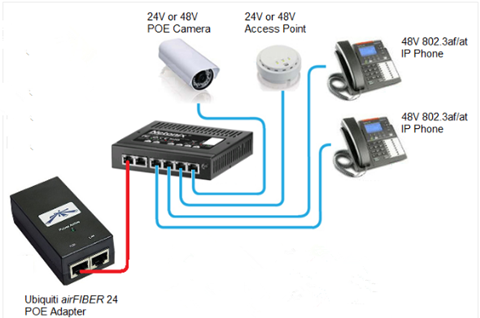
Note that: the No. “6”, “8”, “10”... in those model refers to the numbers of port. And “150” and “250” means the max power consumption. The above image shows the simple home network setup using WS-6-MINI switches.
Optical Transceiver Tested to Work Well in WISP Switches
According to Netonix community, the SFP (optical module form factor) Gigabit Ethernet ports on WISP switches accommodate a full range of SFP optical transceiver modules, including SFP 1000BASE-T, SFP 1000BASE-SX, SFP 1000Base-LX/LH, SFP 1000BASE-ZX, SFP 1000BASE-BX-D, SFP 1000BASE-BX-U, SFP 1000BASE-EX. The following SFP optical transceivers are reported to be working fine on WISP switches.
Major Branded Optical Transceivers For WISP Switches
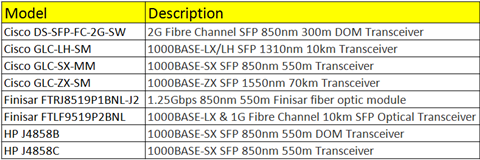
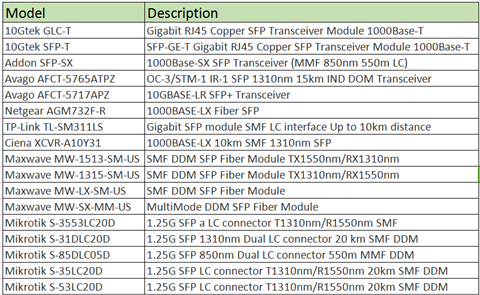
Compatible Optical Transceivers for WISP Switches
Fiberstore compatible optical transceivers are reported to work well on Netonix WISP switches. The following table lists the detailed information about the compatible optical transceiver modules on WISP switches.

Conclusion
The Netonix WISP switches were designed to be part of the Small Business or home networking products that work together as part of proven, fully integrated, easy-to-use small business solution. These switches support a huge number of Gigabit Ethernet SFP optical transceivers. All these high-quality fiber optic transceivers can be found on FS.COM for competitive prices. FS.COM is committed to provide free shipping in USA, Mexico and Australia.
Oznake: compatible gigabit SFP optical transceiver, SFP optical transceiver, Fiberstore SFP-GB-GE-T, GLC-BX-U, GLC-BX-D, GLC-SX-MM, GLC-ZX-SM, GLC-T
komentiraj (0) * ispiši * #
Using A GLC-SX-MM Transceiver To Connect Gigabit Ethernet Network
utorak , 16.08.2016.If you are still using a 100BASE network, or GBIC transceiver for a small office, you may run into the limitations of last decade's technology. Because the 100BASE standard network is just fine for a small office, but it isn't sufficient to handle heavier network use. As your network expands, you might experience problems like: dropouts in your VoIP calls, Sluggish data retrieval speeds, or poor video streaming quality. If you have encountered any of this, maybe it’s time to start thinking about an upgrade to gigabit Ethernet, which moves at ten times the speed of traditional Ethernet. This article will explain the Gigabit Ethernet in the following aspects: the compatible SFP transceiver, the difference between twisted copper and fiber optic Ethernet.
Compatible SFP Transceiver
When contemplating an upgrade to gigabit Ethernet, there are a number of issues involved in the network transition. But one of the most immediate concerns people have is how much new hardware they'll have to purchase. The good news is that one of the basic issues providing connectivity is generally quite easy.
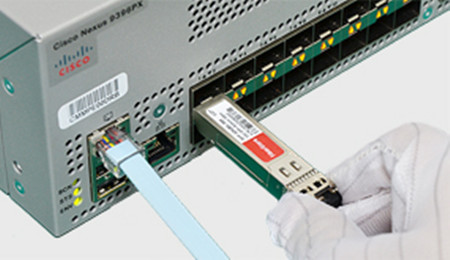
The representative of the optical transceivers for Gigabit Ethernet is Small Form-factor Pluggable (SFP). These Small Form-factor Pluggable slots allow transceivers like the GLC-SX-MM to be plugged in and provide instant gigabit Ethernet connectivity. In the last few years, when you purchased your networking equipment, it should have some industry-standard SFP ports, based on a Cisco standard. And you can only purchase the original expensive SFPs. However, the monopolized SFP market is unhealthy for the development of optical technology, nowadays people can appreciate the low price and high performance of compatible SFP transceivers from OEM vendors.
How to Ensure the Compatibility of the SFP Transceiver
Although the OEM or alternative party compatible SFP transceivers are much cheaper than the original ones, people are hesitated to use them. In fact, there are mainly two factors that will have an impact on the compatibility of the SFP transceivers. First, does the SFP optics require DDM function? Second, does the host equipment check the ID code and lock out alternative party components?
Certainly from our experience, most Cisco core equipment and routers do lock out all but Cisco ID SFP modules. We do not have an extensive report on what Cisco equipment does and does not lock out third party SFP.
The only way to know for sure is to try an authorized component if the host equipment rejects it. Remember, the compatibility has nothing to do with the functions of the transceiver, only in recognizing ID code and selecting to lock out third party SFP or not.
Fiber Optic Cabling Over Copper-wire Cabling
Choose to use copper-wire cabling or upgrade to fiber optic cabling in your offices is another consideration when installing a network. There is no doubt that fiber optics provide several advantages over copper, but it is more expensive than copper cabling. In addition, fiber optic supports far longer cable lengths than twisted copper.
Copper can only run for around 100 meters, whereas fiber can go between 200 and 500 feet, or more, without signal loss. Fiber has gives off no radio interference, allowing it to coexist more easily in an office with a lot of wireless devices. Because of the lack of interference, fiber is also harder to hack into than copper.
For equivalent data rates, optical cable is thinner and lighter than copper wire, and it does not need to be shielded. For these reasons, an optical cable is often lighter in weight and less bulky, and has a smaller bend radius, than the equivalent copper cable, especially with longer cables. These advantages of fiber provide more data center configuration flexibility.
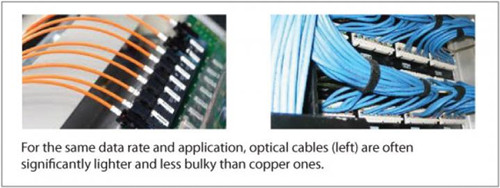
Just as with copper, a standard GLC-SX-MM transceiver links fiber optic Ethernet with your existing equipment. Or the GLC-SX-MM-RGD transceiver is also just great for your network, which is the 1000BASE-SX SFP GLC-SX-MM transceiver with DOM support.
For future proofing, moving away from copper is probably a good idea. Fiber optics are growing steadily in popularity among businesses which have taken over large office buildings, created expansive complexes, or need to collaborate with remote offices in real time.
Additional Information
The biggest advantage of Cisco's SFP system is that it's entirely hot-swappable. It doesn't matter what the device is, from servers to your switch to simple Ethernet cards: If it has an SFP port on it, it can support a multitude of transceivers for different functions, through one standardized interface. In fact, that standardization means that third parties can produce transceivers which are as good as official Cisco units. So, if you decide that fiber optic gigabit Ethernet is what you need for your future business communications needs, the GLC-SX-MM transceiver is truly simple to install and use.
Conclusion
End-users are wondering about whether they should upgrade to higher-bandwidth network as the existing network like 100BASE standard is fine for their network. However, the transition to higher internet speed is going to happen sooner or later. There are several different gigabit Ethernet standards out there, so keep in mind to see which best fits your vision for the future of your business. Note that you'll need transceivers like the GLC-SX-MM to connect your existing devices to the new network.
Oznake: GLC-SX-MM, GLC-SX-MM-RGD, SFP optics
komentiraj (0) * ispiši * #
